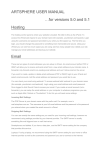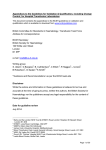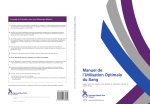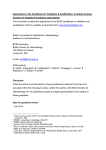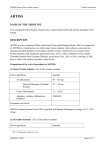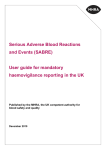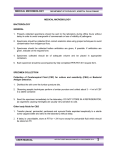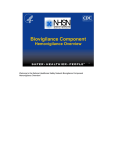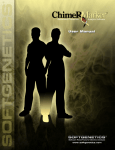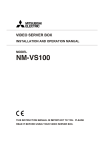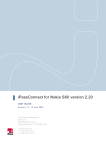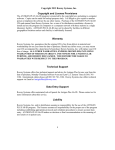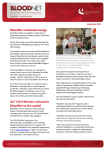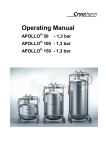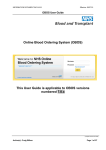Download SHOT Dendrite User Manual v4
Transcript
SHOT Dendrite Database UserManual SHOT Manchester Blood Centre Plymouth Grove Manchester. M13 9LL Phone 0161 423 4208 e-mail [email protected] website http://www.shotuk.org Introduction SHOT is improving the way that you make adverse incidents reports. Currently to report to SHOT you first make a notification report via SABRE ticking a box to say that you will share the report with SHOT or that want to make a SHOT only report. Then the relevant SHOT questionnaire is allocated by the SHOT office and you receive an e-mail stating that the questionnaire is available for completion. The questionnaire part of the process is going to cease and be replaced by a link to a new online web based database into which you can enter your data directly. In future when you make a report to SABRE and tick the SHOT box, SABRE will send a message to the new SHOT database creating a record for this report. The next day the new SHOT database will e-mail you, the reporter, with a link to the newly created record in the database. Click on the link and it will take you directly to the case you have notified to SABRE. You will be asked to login to the SHOT database at that point so that you can complete the record. The new database will make the process of making a SHOT report much easier and quicker as well as providing an enhanced level of security for the data that you provide SHOT with. However to make this work and to comply with government and NHS regulations on information governance, you will need to register with the new database. Registering on the database Registering on the database is simple. Ask the SHOT office for a registration form, complete it and return it to the SHOT Office. Important - please note that you need to supply exactly the same e-mail address that you use to log-in to SABRE on the registration form. This will be used as the method for identifying messages from SABRE about your reports. You do NOT need to provide your SABRE registration number or password. Dendrite will provide reporters with a login and password. Please note that the system will ask you to change your password as you login for the first time. Please note that your new password will need at least eight characters with a minimum of one upper case, one lower case and one number Who to contact If you are having problems with the SHOT Dendrite database or your SABRE Login or contact details change, please contact the SHOT Office by phone on 0161 423 4208 or by e-mail to [email protected] Reporting an Adverse Event or Reaction to SABRE To report an adverse event to SHOT you must first make a report to SABRE and then tick the “Share this Report with SHOT” box or the “SHOT only report” box. SABRE will then notify the SHOT Dendrite database and create a record for you to complete and then send you an automated e-mail with a link to the database. Please note that this not a “real time process” and it may be a day or so before you receive your e-mail from the SHOT database. The SHOT database Logging into the Database To login into the database, you will need to use the User Name and the password which will have been sent to you by Dendrite. Completing a SHOT database record When you have logged in you will be taken to the Reported Event Search page which will show you a list of the reports that you have made. The newest entry will be shown at the top of the list and will be called “New Registration” and will also show the MHRA reference number. Double click on the entry and you will be taken to the Registration Details page. Some fields will already be populated and you will need to complete the rest of the fields. The database has been designed so that the response to certain questions will determine which pathway you will be taken down. If you are reporting an incident related to Anti-D or Cell Salvage you will be taken to the relevant pages. If you are reporting an incident related to blood and blood components (labile components), you will asked if the blood or blood component was transfused. If you answer “No”, you will be taken down the Near Miss Incident pages. If you answer “Yes” you will be taken to the Transfusion Event page via the Implicated Component and Indication for Transfusion and Transfusion pages which you will need to complete. At the Transfusion Event page, you will be asked if the Transfusion Event was an Adverse Event, Physiological Reaction or Transfusion Transmitted Infection. The choice of reporting category that you make here will determine which pathway you are taken down. Further information about the SHOT reporting categories and the data that is required for each category is available for download from the Documents section of the database. To access them go to Main Menu from the Event Search page and click on the Documents button. Documents available: Dataset for each reporting category, Simple User Guide, SHOT Dendrite database User Manual, SHOT Toolkit and the Root Cause Analysis Toolkit for Transfusion Practitioners. Hover Prompts Some fields will show what is known as a Hover Prompt when you rest the cursor on them. They contain definitions or what information is required to complete the field. While the cursor rests on them they will persist and will only disappear when you move the cursor on. See below. Navigating the database and saving records To navigate your way through the database, you need to use the Previous Page and Next Page which are situated at the top and bottom of every page. When you click on these buttons the data on the screen will be saved and you will move onto the next page or the previous page. The data on the screen will also be saved if you use the Save and Exit button. See below Uploading documents Where it is relevant, there will be a document upload facility which will allow you to upload any documents which you think are relevant such as Root Cause Analyses. We would encourage you to do this so that SHOT can provide a thorough analysis for the SHOT Report. Entering denominator data. There is a facility for reporters to enter their reporting organisation‟s component issues and transfusion data for the previous year. The dataset for this is identical to the yearly return of units issued and units transfused that is requested by the MHRA and SHOT requests that you enter the data that you return to the MHRA onto the SHOT database as well. See below. To enter the data go to the Main Menu and click on the Enter ARED Data (ARED stands for Annual Reporting Establishment Denominator data) Dataset for Annual Component Denominator Return For red cells, whole blood, plasma, platelets and other category Number of units issued (total number of units issued with a given number of blood components) Number of recipients transfused (total number of recipients transfused with a given number of blood components) Number of units transfused (the total number of blood components (units) transfused over the reporting period) Entering Data Please note any patient or staff identifiable information must not be included in the record or in any documents that you upload. All incidents The following data fields need to be filled in for all incidents Date and time of event Event time Date of birth of patient Gender of patient Brief description of event If you are reporting a Near Miss where no patient was involved, date of birth or gender needs to be entered. Where component transfused The following data fields need to be filled in for all incidents where a component was transfused. Implicated component-include any special requirements Source of component Diagnosis Operation/Procedure Indication for component transfusion Was transfusion clinically indicated according to relevant BCSH guidelines Date and time of the transfusion What was the priority of the transfusion (routine or emergency) The speciality that the transfused patient was under. Type of event that you are reporting – Adverse event, Physiological reaction or transfusion transmitted infection o Adverse Event IBCT-Wrong component transfused IBCT-Special Requirements not Met Unnecessary or Inappropriate transfusions Handling and storage errors Right Blood Right Patient o Physiological Reaction Acute Transfusion Reaction Haemolytic Transfusion Reaction Post Transfusion Purpura Transfusion associated Graft versus Host Disease Pulmonary Complications Of Transfusion Transfusion Associated Circulatory Overload Transfusion Associated Acute Lung Injury Transfusion Associated Dyspnoea Previously Uncategorised Complication of Transfusion Haemosiderosis (Optional reporting category) Alloimmunisation (Optional reporting category o Transfusion Transmitted Infection When you have entered the type of event that you are reporting you will be taken down the pathway for that event. For further details on what data is required, please download the SHOT Toolkit and the SHOT Dendrite datasets for each reporting category. Brief outlines for all of the current reporting categories are given below. Completing a record When you have entered all of the data necessary into the record and feel that it is complete, please ensure that the Record Completed box on the final page of the record is ticked. Reporting Categories The following reporting categories give a brief outline of what needs to be reported to SHOT. For more detailed information on these, please download the SHOT Toolkit. Cell salvage Adverse events and reactions related to the use of intraoperative and postoperative cell salvage. Incidents to be reported: Adverse events due to operator error Adverse events due to machine failure Adverse clinical events Reactions to reinfused blood Anti-D Events relating to the administration of anti-D immunoglobulin. Please note that this category now includes events relating to the administration of anti-D following transfusion of D-mismatched platelets. Reports in this section include: Omission or late administration. Anti-D given to a D Positive patient or a patient with immune anti-D. Anti-D given to mother of a D Negative infant. Anti-D given to wrong patient. Incorrect dose of anti-D given. Anti-D given that was expired or out of temperature control. Near Miss A near miss is an error or deviation from standard procedures or policies that is discovered before the start of the transfusion and that could have led to a wrongful transfusion or to a reaction in a recipient. For all incidents where there was no transfusion. Do NOT report incidents in this category which involve the use of a component which should not have been transfused but which, nevertheless, was transfused but did no harm. Adverse Events Wrong Blood Transfused (Incorrect or Inappropriate Blood Component Transfused) All reported episodes where a patient was transfused with a blood component or plasma component which was intended for another patient. This category currently includes: Patients receiving a blood component intended for a different patient. Patients receiving blood of an incorrect group, including components of an incorrect group given to BMT/SCT or solid organ transplant patients. Special Requirements Not Met (Incorrect or Inappropriate Blood Component Transfused) All reported episodes where a patient was transfused with a blood component or plasma product that did not meet the appropriate requirements. Transfusion of blood of inappropriate specification or that did not meet the patient‟s special requirements. e.g. failure to provide CMV neg components, irradiated components or blood of incorrect phenotype. Also failure to provide the correct component to patients born after 1991. Unnecessary or Inappropriate transfusions These are cases in which the intended transfusion is carried out, and the component itself is suitable for transfusion and for the patient, but where the decision making is faulty. There are also cases where a transfusion of blood or a blood component was clinically indicated but was not undertaken. This category includes: Prescription of components that are not required or where another component or therapy would have been more clinically appropriate Prescription at an incorrect dose or rate Failure to transfuse or under transfusion Handling and Storage Errors Transfusion of a correct component to an intended patient, when handling or storage errors may have rendered the component less safe for transfusion. „Unsafe‟ transfusion where there were handling or storage errors such as a component out of temperature control, or delay in completion of transfusion. Right Blood Right Patient Incidents where a patient was transfused correctly despite one or more serious errors which in other circumstances might have led to an IBCT. Includes labelling errors and administration with incorrect or missing details Physiological Reactions Acute Transfusion Reaction Reactions occurring at any time up to 24 hours following a transfusion of blood or components, excluding cases of acute reactions due to incorrect component being transfused, haemolytic reactions, transfusion-related acute lung injury (TRALI), transfusion-related circulatory overload (TACO), Transfusion Associated Dyspnoea (TAD) or those due to bacterial contamination of the component. Reactions that need to be reported are: o Isolated febrile – a rise in temperature of > 1 C +/- minor rigors and chills. Minor allergic – skin +/- rash Anaphylaxis– hypotension with one or more of: urticaria, rash, dyspnoea, angioedema, stridor, wheeze, pruritis, within 24 hours of transfusion. Severe allergic reaction – Severe allergic reaction with risk to life occurring within 24 hours of transfusion, characterised by bronchospasm causing hypoxia, or angioedema causing respiratory distress. Hypotension – a drop in systolic and/or diastolic pressure of >30mm Hg occurring within one hour of completing transfusion, provided all other adverse reactions have been excluded together with underlying conditions that could explain hypotension. o Febrile with other symptoms/signs – rise in temperature of >1 C, with no features of an allergic reaction, but with one or more of myalgia, nausea, change in blood pressure or hypoxia Haemolytic Transfusion Reaction Acute Acute HTRs are defined as fever and other symptoms / signs of haemolysis within 24 hours of transfusion; confirmed by one or more of the following in: a fall of Hb, rise in LDH, positive DAT and positive crossmatch. Delayed Delayed HTRs are defined as fever and other symptoms / signs of haemolysis more than 24 hours after transfusion; confirmed by one or more of: a fall in Hb or failure of increment, rise in bilirubin, positive DAT and positive crossmatch not detectable pre-transfusion. Simple serological reactions (development of antibody without positive DAT or development of haemolysis) are excluded. Please report these in the Alloimmunisation category. Post Transfusion Purpura Thrombocytopenia arising 5 – 12 days following transfusion of red cells, associated with the presence in the patient of alloantibodies directed against the HPA (Human Platelet Antigen) systems. Cases where the platelet count drops more than 50% following transfusion should be investigated and reported if complete or partial serological evidence is available. Previously Uncategorised Complication of Transfusion Physiological reaction or adverse effect in temporal association with transfusion which can not attributed to already defined side effects and with no other risk factor other than transfusion. To include reactions or adverse effect that may be due to the introduction by blood services of new component processing techniques e.g. prion filtration. Transfusion Associated Graft-versus-Host Disease Characterised by fever, rash, liver dysfunction, diarrhoea, pancytopenia and bone marrow hypoplasia occurring less than 30 days after transfusion. The condition is due to engraftment and clonal expansion of viable donor lymphocytes in a susceptible host. Please report all cases where diagnosis is supported by skin / bone marrow biopsy appearance or confirmed by the identification of donor-derived cells, chromosomes or DNA in the blood and/or affected tissues and cases with a very high index of clinical suspicion. Pulmonary Complications of Transfusion Transfusion Associated Circulatory Overload Defined by any four of the following occurring within six hours of transfusion: Acute respiratory distress. Tachycardia. Increased blood pressure. Acute or worsening pulmonary oedema. Evidence of positive fluid balance. Transfusion Related Acute Lung Injury Acute dyspnoea with hypoxia and bilateral pulmonary infiltrates during or within six hours of transfusion, not due to circulatory overload or other likely cause. Suspected cases should be discussed with a Blood Service Consultant, and reported if there is a high index of suspicion, even if serological investigation is inconclusive. Transfusion Associated Dyspnoea TAD is characterized by respiratory distress within 24 hours of transfusion that does not meet the criteria of TRALI, TACO, or allergic reaction. Respiratory distress should not be explained by the patient‟s underlying condition. Transfusion Transmitted Infections Include as a TTI if, following investigation, the recipient had evidence of infection posttransfusion, and there was no evidence of infection prior to transfusion and no evidence of an alternative source of infection. Plus; Either at least one component received by the infected recipient was donated by a donor who had evidence of the same transmissible infection. Or at least one component received by the infected recipient was shown to contain the agent of infection. Cases of bacterial transmission from blood components, where cultures from the patient‟s blood match cultures from the component bag and/or from the donor. Transmissions of viruses, whether routinely tested for by the blood services or not. Transmissions of other agents such as prions, protozoa and filaria. All suspected Transfusion Transmitted Infections must be reported to the Blood Service as a matter of urgency Optional Reporting Categories Reporting of incidents in these categories is not required by SHOT but would be welcomed . Alloimmunisation Alloimmunisation occurs when, after a transfusion, there is demonstration of clinically significant antibodies against red blood cells which were previously absent (as far as is known) and when there are no clinical or laboratory signs of haemolysis. This term is categorised as a Delayed Serological Transfusion Reaction by the ISBT Development of an antibody with positive DAT or development of haemolysis is excluded. Please report these in the Haemolytic Transfusion Reaction category. Haemosiderosis Iron overload as indicated by laboratory investigation or biopsy due to chronic transfusion and which can result in organ injury (Heart, Lung, Liver and or Endocrine glands). Any cases of chronically transfused patients that require iron chelation therapy. Imputability, Mortality and Morbidity Imputability When assessing imputability. i.e. what was the relationship between the adverse reaction and the transfused component, please use the imputability criteria in the table below. N/A Not assessable Imputability When there is insufficient data for imputability 0 Excluded or Unlikely 1 Possible 2 Likely / probable 3 Certain assessment When there is conclusive evidence beyond reasonable doubt for attributing the adverse reaction to causes other than the blood or blood components or where the evidence is clearly in favour of alternative causes. When the evidence is indeterminate for attributing the adverse reaction either to the blood or blood component or to alternative causes When the evidence is clearly in favour of attributing the adverse reaction to the blood or blood component. When there is conclusive evidence beyond reasonable doubt for attributing the adverse reaction to the blood or blood component Mortality When assessing mortality. i.e. what was the relationship between the adverse reaction and the death of the patient, please use the mortality criteria in the table below. Mortality Death directly and solely caused by the transfusion reaction Death which may not have occurred at that time had the reaction not taken place Death unrelated to the transfusion or reaction Patient recovered and survived Morbidity Morbidity should initially be assessed as major or minor morbidity or no reaction. When assessing major morbidity. i.e. what was the relationship between the adverse reaction and the level of morbidity suffered by the patient, please use the morbidity criteria in the table below. Major Morbidity Intensive care admission and/or ventilation Dialysis and/or renal impairment Major haemorrhage from transfusion induced coagulopathy Jaundice including evidence of intravascular haemolysis Potential D sensitisation of a woman of child bearing age Persistent viral infection Acute symptomatic confirmed infection Reaction resulting in low or high haemoglobin level of a degree sufficient to cause risk to life unless there is immediate medical intervention











